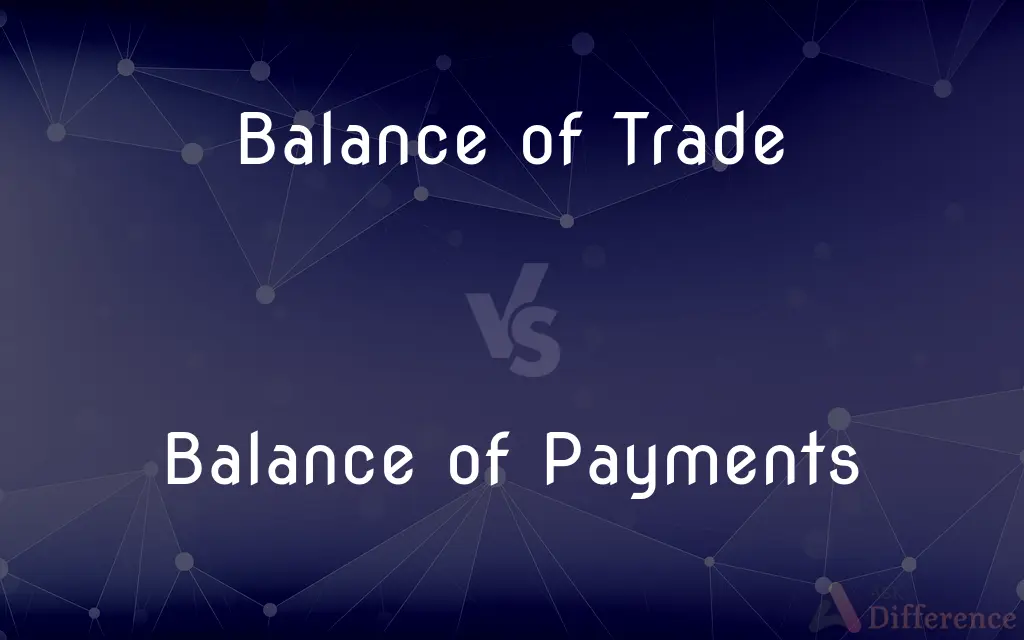Balance of Trade vs. Balance of Payments — What's the Difference?
By Tayyaba Rehman — Published on October 1, 2023
Balance of Trade refers to the difference between a country’s exports and imports of goods, while Balance of Payments is a broader term, accounting for all financial transactions between a country and the rest of the world, including goods & capital flows

Difference Between Balance of Trade and Balance of Payments
Table of Contents
ADVERTISEMENT
Key Differences
Balance of Trade is a significant economic indicator, reflecting the value of a country's exported goods versus its imported goods. In contrast, Balance of Payments is more comprehensive, incorporating not only trade in goods but also services, financial transfers, and investments, painting a fuller picture of a country's economic interactions with the rest of the world.
The term Balance of Trade is crucial for economists and policymakers as it helps in understanding the economic health of a nation by analyzing its trade patterns. Balance of Payments, on the other hand, gives an in-depth insight into the economic stability and sustainability of a country by considering all its international economic activities.
Balance of Trade, when positive, signifies a trade surplus, meaning a country exports more goods than it imports. In comparison, a positive Balance of Payments may indicate that more money is flowing into the country through trade, investments, and other transfers, enhancing its economic standing.
A negative Balance of Trade, or trade deficit, occurs when a country imports more goods than it exports. Whereas, a negative Balance of Payments suggests that more money is flowing out of the country, potentially leading to economic instability and depletion of foreign exchange reserves.
Balance of Trade is largely concerned with tangible goods, offering a narrower perspective on international economic transactions. In contrast, Balance of Payments offers a panoramic view, including services, income, and financial transactions, thus serving as a more detailed representation of a country's economic relationships.
ADVERTISEMENT
Comparison Chart
Definition
Measures the difference between the value of exports and imports of goods.
Encompasses all transactions between a country and the rest of the world, including goods, services, and capital flows.
Scope
Narrow, only considers trade in goods.
Broad, includes goods, services, financial transfers, and investments.
Indicator of
Economic health through trade patterns.
Overall economic stability and international economic activities.
Surplus/Deficit Implications
A surplus implies more exports than imports, a deficit means more imports than exports.
A surplus means more inflow of money, a deficit implies more money flowing out, affecting economic stability.
Reflection
Reveals trade patterns and competitiveness in goods market.
Illustrates a comprehensive view of international economic relationships.
Compare with Definitions
Balance of Trade
Balance of Trade is the differential value between a nation's exports and imports.
The balance of trade becomes negative when the value of imports exceeds that of exports.
Balance of Payments
Balance of Payments provides comprehensive insights into international economic activities.
A well-maintained balance of payments ensures economic stability and boosts investor confidence.
Balance of Trade
Balance of Trade serves as an essential indicator of a country's economic health.
A sustained negative balance of trade often leads to the depletion of a country's foreign exchange reserves.
Balance of Payments
Balance of Payments reveals the financial transactions impacting a country's foreign exchange reserves.
Persistent deficits in the balance of payments can lead to a depletion of foreign exchange reserves, affecting currency value.
Balance of Trade
Balance of Trade provides insight into a country’s competitive standing in the international market.
By analyzing the balance of trade, economists can infer the international demand for a country's products.
Balance of Payments
Balance of Payments is indicative of a country’s economic stability and international financial standing.
A nation’s economic policies are often shaped to maintain equilibrium in the balance of payments, ensuring economic health.
Balance of Trade
Balance of Trade is a subset of the balance of payments, focusing solely on goods.
A country can have a deficit in its balance of trade but maintain equilibrium in its balance of payments through services and capital flows.
Balance of Payments
Balance of Payments is the record of all economic transactions between residents of a country and the rest of the world.
A positive balance of payments indicates a country’s strong economic position, reflecting more inflow than outflow of funds.
Balance of Trade
Balance of Trade is the economic measure of exported goods less imported goods.
A favorable balance of trade is achieved when a country exports more than it imports.
Balance of Payments
Balance of Payments encompasses goods, services, financial transfers, and investments.
Analyzing the balance of payments helps in understanding a country's economic relationships and sustainability.
Common Curiosities
What does Balance of Payments include?
Balance of Payments includes all international economic transactions of a country, covering goods, services, and capital flows.
How is Balance of Payments different from Balance of Trade?
Balance of Payments is broader, including all financial transactions with other countries, while Balance of Trade only considers goods.
Can Balance of Trade be negative?
Yes, Balance of Trade is negative when a country imports more goods than it exports, called a trade deficit.
Why is Balance of Trade important?
Balance of Trade is important as it reflects a country’s competitiveness and economic health through its trade patterns.
What is Balance of Trade?
Balance of Trade is the difference between the value of a country's exports and imports of goods.
How can a negative Balance of Trade be counteracted?
Enhancing competitiveness, increasing exports, reducing imports, or implementing trade policies can help counteract a negative Balance of Trade.
Can a country have a positive Balance of Payments with a negative Balance of Trade?
Yes, a positive inflow in services, investments, or financial transfers can offset a negative Balance of Trade, resulting in a positive Balance of Payments.
How does Balance of Payments affect currency value?
Balance of Payments affects currency value as a surplus can lead to an appreciation, while a deficit can lead to depreciation of the national currency.
How does a surplus in Balance of Trade affect an economy?
A surplus in Balance of Trade implies more exports, potentially leading to economic growth, increased production, and job creation.
Is a deficit in Balance of Payments always bad?
A deficit in Balance of Payments may indicate economic instability, but it isn’t always detrimental, depending on a country’s reserves and economic context.
What can lead to an imbalance in the Balance of Payments?
Trade imbalances, fluctuations in international capital flows, and variations in foreign exchange rates can lead to an imbalance in the Balance of Payments.
What is reflected by a country's Balance of Trade?
Balance of Trade reflects a country’s trade patterns, international demand for its goods, and its competitive standing in the global market.
Share Your Discovery

Previous Comparison
Tempering vs. Austempering
Next Comparison
Consignment vs. PartnershipAuthor Spotlight
Written by
Tayyaba RehmanTayyaba Rehman is a distinguished writer, currently serving as a primary contributor to askdifference.com. As a researcher in semantics and etymology, Tayyaba's passion for the complexity of languages and their distinctions has found a perfect home on the platform. Tayyaba delves into the intricacies of language, distinguishing between commonly confused words and phrases, thereby providing clarity for readers worldwide.
















































